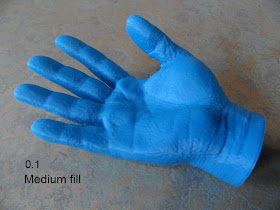- A printable model. See posts in this blog: "Model build setup", "Part orientation and Part scaling".
- Make sure the print bed is level. NOTE: See my other post "print bed leveling aid", This is a "must" do, so you don't have to remove your top print platform to adjust the leveling. Once I have leveled the print bed, I only re-check it after a couple of prints if I keep printing smaller parts. For large parts, I would recommend checking it before every print, since it is critical to have the proper gap over the entire large part to maximize first layer adhesion and therefor minimize the part warping and pulling up from the print bed.
- Check the z-gap before every print. This is a quick check and easy to adjust, but it is critical to get good adhesion to the print bed. (I set the gap to just under 0.1mm or even smaller for large parts) Some use a sheet of paper for checking the z-gap. Before checking the z-gap, make sure there is not any dried up plastic at the end of any print jet before checking the z-gap. Sometimes it's just a tiny piece of plastic stuck at the end of the jet tip and it can give you a wrong z-gap reading. I will run some tests and see how stable the z-gap stays after removing the print bed several times. Also will try if "Homing" before every print will make any difference.
- Have the proper amount of glue applied on the print bed. For PLA you only need a very thin even layer of glue. I spread the glue very thin evenly over the print area and let it get tacky. If you apply too much glue or don't let it get tacky, the plastic might smear on top and not stick. If you apply too little glue or no glue, the plastic might not stick as well. The glue also helps to remove after the print since it is water dissolvable. Overall it does not need much glue for PLA, just and even tacky thin layer. I swipe back and forward over the applied glue with the foam of the glue stick to even out the glue and to make it evenly tacky. I apply the glue before loading the file, that gives the glue some time to get tacky.
- Make sure all print heads are level, so they don't hit the model. Before starting the print, make sure there is not any dried up plastic at the end of any print jet which could mess up your model printed on another jet.
My standard routine:
- Power up the printer. (the print bed was already cleaned after the last print).
- Select the "Home" button. This will move the print jet behind the print bed so you can do step three.
- Make sure the jets don't have any (not even a tiny piece at the tip) of filament left stuck on them otherwise it can affect your z-gap measurement.
- Only for larger parts I recheck the print bed leveling to ensure good adhesion over the whole part.
- Hit the "z-gap" menu button and check or adjust the z-gap with the up/down button.
- For PLA spread a very thin even layer of glue to the print bed area the print will be on.
- Insert the memory stick with the print file and load the print file.
- Make sure the glue is tacky.
- Start the print.
- The print jet will heat up and then it starts printing.
- I watch when the first few layers get printed to confirm I had the z-gap correct and then let it print.















